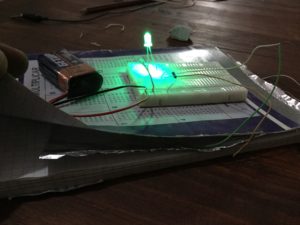 UNESCO Director-General, Irina Bokova mentioned in the 11th annual Education for All global monitoring report that “poor quality [of education] is holding back learning even for those who make it to school.” (Provost, 2014). This is about literacy, though. What about fabrication and making? The remaining question to answer is: how can we get millions of people living in the base of the pyramid communities used to fabrication and making? If those people cannot get access to quality education, how is possible they get skills to exploit any tools and be part of world’s fast-growing maker movement?
UNESCO Director-General, Irina Bokova mentioned in the 11th annual Education for All global monitoring report that “poor quality [of education] is holding back learning even for those who make it to school.” (Provost, 2014). This is about literacy, though. What about fabrication and making? The remaining question to answer is: how can we get millions of people living in the base of the pyramid communities used to fabrication and making? If those people cannot get access to quality education, how is possible they get skills to exploit any tools and be part of world’s fast-growing maker movement?
Being exposed to the concepts of electricity and electronics for the first time is so scaring, ahem-ahem, but brings much curiosity of exploring how things work. In developing countries where maker movement is lagging behind that of the developed countries, kids learn everything in theories but to put hands-on experiments is rare to happen, not because they don’t want to but because there are no means to practice what they learn. What if they get access to practical hands-on experiences and get the freedom to explore how things in fabrication get executed? It’s undoubted that they can be part of maker movement where innovators behave as independent inventors, designers, and tinkerers as described by the Time Magazine. The key indicator that students in the developing world have many theories is that if high school students asked anything about electricity and electronics, they could tell everything they have learned in physics; ugh, which is not too bad, though.
For students to get things work, they would need to know how industrial materials are built and try to rebuild them using raw materials. This is being said that the learners would need to explore by themselves how they can be able to build their own things and try to make them work as industrial components do. That’s what 2nd-year (8th grade) students of high school level have been doing with capacitors and resistors at Kepler Tech Lab, a science and engineering teaching laboratory-based in Kigali, Rwanda while experiencing concepts of electricity.
Homemade Resistor
Every material is resistive, meaning that it resists charge going through it. Even a conductor, like a copper wire, has some resistance. A commonly available and easily shapeable resistive material is graphite, which you can draw into any size or shape. Given their background of theory-based knowledge, it took students who take engineering class with Kepler Tech Lab about two weeks to get a better understand of how a resistor works through the variety of experiments. They took a clean sheet of paper and draw some shapes on it with pencil and calibrated multimeter on the “resistance” setting where they measured resistor’s quantity called resistance.
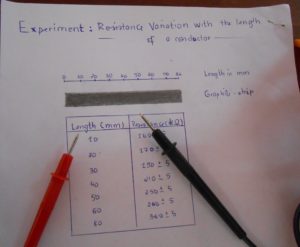
Particles of graphite on paper for resistivity activity
The engineering class at Kepler Tech Lab for ordinarily level (O’level) students of high school is intended to get them used to practical hands-on experiences during their young ages.
Homemade Capacitor
Breaking things down and show students how things are built gives them a chance to compare what has been already made and what they are about to make. This leaves enough room for them to be more creative while arranging required materials to assemble their own components. A capacitor as a component used to store charges has been broken into pieces and students were excited to see how it is made with only layers, insulators, and electrodes (anode and cathode). A homemade capacitor has 2 sheets of tin foil as the conductor and sheet(s) of papers as the insulator. To get it work, makers start with 3 large sheets: 2 of tin foil and 1 of paper. Sandwich the paper between the 2 pieces of tin foil, and make sure that the tin foils are not touching each (see Figure 2). If that happens, current will flow between the two pieces and no charge will be stored. In order to secure the placement of the sheets, pieces of tape should come into a play, and then, calibrate the multimeter on the “capacitance” setting to see if you can be able to measure a capacitance between the paper and the tin foil.
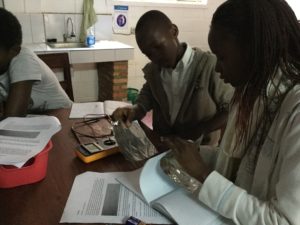
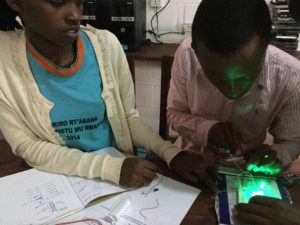
Students putting layers of papers as spacers between tin foils while experimenting with capacitor
What about if students cut the pieces smaller and measure the capacitance again? To do that allow them to explore the effect of surface area of the tin foil. What if they use multiple sheets of papers or other spacers to change the spacing between the two sheets of tin foil? The students must be encouraged to keep iterating their experiments and note down all changes they are getting. It is recommended that students work in groups and the first group to finish the activity gets an opportunity to mentor their fellow classmates.
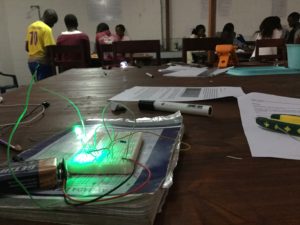
Students leaving their stations and teach fellow students what they’ve made and how they made it
The same capacitor can also be made using salt, water, tin foils as conductors, and a plastic water bottle as an insulator. First, the bottle has to be filled with water dissolve a spoon full of salt into water. Tin foil is wrapped around the bottle without wrinkles on the foil. An easy way to do this is to flatten the tin foil and gently roll the water bottle in it, taking care to smooth out any wrinkles. After that, screw on the top of the water bottle, and poke a nail through, so that the bottom of the nail touches the water. Then, capacitance has to be measured between the nail and the foil. Students should keep exploring more what happens if they add more salt, use less tin foil, or if they add a sheet of paper between the tin foil and the plastic bottle.
Like any other learners, young students in developing world need to exercise how things work by trying to make their own and use them in their projects. I do believe that they get the most of making things rather than handing them industrial/finished products, which is not bad, to be used without knowing how they are built. Hang in there and see what future generation of makers will bring to the world’s changing technologies.
References
Provost, C. (2014, January 28). One in four young people in developing countries unable to read, says UN. Retrieved February 19, 2018, from https://www.theguardian.com/global-development/2014/jan/29/illiteracy-education-young-people-developing-countries
This is so cool, Alphonse. Giving youth a hands-on experience of simple components like resistors and capacitors is such a great idea. It’s so interesting that you posted this because in youth in our program tell us what they need to learn. This year, they told us that they want more basic electronic skills that go beyond what they learn with squishy circuit type experiments before they start doing physical programming. So you have given me more ideas about where to start with them!
Hey Susan, it’s super interesting to give young students such kind of experiments, which are not funny activities, but they end up turning them into funny activities. My students have really enjoyed playing around with homemade capacitors and resistors and become excited of what they can built. I hope you are going to have the same experience with your students as well! In next few days, I am going to have them working with Squishy Circuits and I cannot wait to share their experience. Next year (2017), it’s phyical computing!! We have already started doing this with Arduino but students have some challenges with concepts of electronics and computer programming which I am trying to address before!!!
Alphonse, I love that this is a practical and tangible way to understand resistors and capacitors. I often have to find creative ways to explain it to elementary students, but I really like the idea of drawing and measuring distance in relation to resistance. I may try this! Thank you for the inspiration!
Angie, thank you so much for your plausible comment about the article. I am glad to hear that the exercises can be applicable in your classroom setting. I am sure kids will like them. Today, I used Squishy Circuits with doughs (a blog post to be shared shortly) and they surprised me with creativity and critical thinking, not to forget some innovations!!:-)
Alphonse, I am going to try this with my students! Thank you for posting.
Dear Erin, I am happy you can try this in your classroom setting. Students will enjoy the activities, I am telling! Do you remember thinking exercises we did together at Castilleja School? I want to try them with my students but I am not sure where to start. They are young and I am worried about giving them appliance to disassemble. Have you tried them so I can learn from your experience?